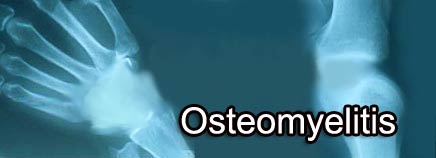
If your kids are like most, they’re probably pretty active and not always as careful as they should be. Minor scrapes and bruises that develop on their arms and legs will usually heal on their own — but deeper wounds that are left untreated can become infected, and lead to a bone infection. In medical terms, that’s called osteomyelitis.
Osteomyelitis is most commonly caused by the bacterium Staphylococcus aureus, but other bacteria can cause it, too. Germs usually enter the body’s tissues through an open wound (often a broken bone that breaks the skin), but can also travel to a bone through the bloodstream from another infected area in the body (this is called hematogenous osteomyelitis).
A bone also can become infected when the blood supply to that area is disrupted, such as in older people with atherosclerosis (a narrowing of the blood vessels) or in those with diabetes. Atherosclerosis or diabetes-related bone infections usually occur in the toes or other bones in the feet. Osteomyelitis from other causes usually affects the long bones of the arms and legs.
Signs and Symptoms
Kids with osteomyelitis often feel severe pain in the infected bone, and might have fever and chills, feel tired or nauseated, or have a general feeling of not being well. The skin above the infected bone may be sore, red, and swollen.
It’s often difficult to diagnose osteomyelitis in infants and young children because they don’t always show pain or feel specific symptoms in the area of the infection. Additionally, older people with atherosclerosis or diabetes sometimes lose the ability to feel pain (called neuropathy), so their symptoms also might not be evident. In teens, who tend to develop osteomyelitis after an accident or injury, the injured area may begin to hurt again after initially seeming to get better.
Diagnosis
If your child has a fever and bone pain, visit the doctor right away. Waiting is not recommended because osteomyelitis can get worse within hours or days and become much more difficult to treat.
The doctor will perform a physical exam and ask questions about recent injuries to the area that’s painful. Blood tests might be done to see whether the white blood cell count is elevated (a sign of infection) and to look for signs of possible inflammation or infection in the body. An X-ray may be ordered; however, X-rays usually don’t show signs of infection in someone who has had osteomyelitis for a little while.
If osteomyelitis is suspected, the doctor might suggest a bone scan, which provides a more detailed look at the bone. The doctor might also recommend an MRI (magnetic resonance imaging), which produces much more detailed images than X-rays. MRIs not only can diagnose osteomyelitis, but can help establish how long the bone has been infected.
Treatment
Treatment of osteomyelitis depends on the severity of the infection and whether it is acute (recent) or chronic (has been present for a longer period of time). The doctor may perform a needle aspiration, removing a sample from the bone to help identify the bacteria responsible for the infection, which will help determine the correct antibiotic to treat that particular infection.
A child who’s diagnosed with severe osteomyelitis may be admitted to the hospital for a short stay so that intravenous (IV) antibiotics can be given to fight the infection. Once the condition improves, kids can go home but may need to continue IV or oral antibiotics for several more weeks.
In cases where a cavity or hole developed in the bone and pus (a large collection of bacteria and white blood cells) filled this area, a doctor will perform debridement. This is a procedure to clean the wound, remove dead tissue, and drain pus out of the bone so that it can heal properly.
Prevention
The easiest way to prevent osteomyelitis is to practice good hygiene. All cuts and wounds — especially deep wounds — should be cleaned thoroughly. Wash a wound with soap and water, holding it under running water for at least 5 minutes to flush it out.
To keep the wound clean afterward, cover it with sterile gauze or a clean cloth. You can apply an over-the-counter antibiotic cream, too, but the most important thing is to keep the area clean. Wounds should begin healing within 24 hours and completely heal within a week. A wound that’s taking longer to heal or is causing your child extreme pain should be examined by a doctor.

